LoRaWAN and its contribution to IIoT
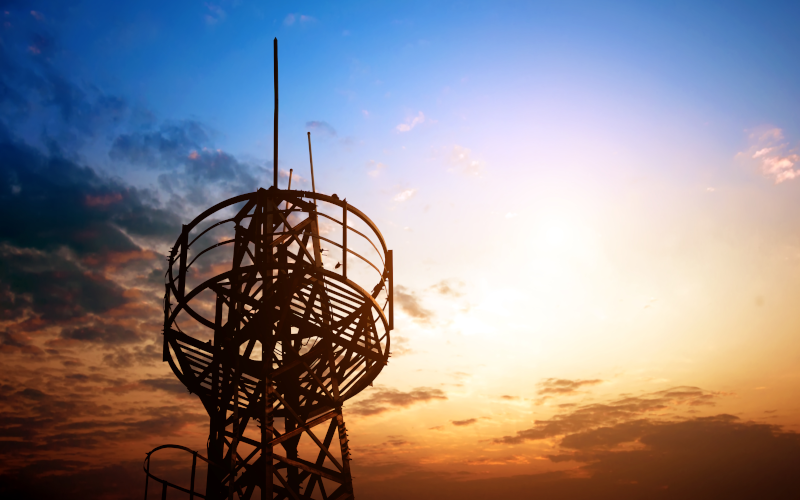
The Industrial Internet of Things (IIoT) has experienced considerable growth over the last few years, providing a wealth of improvements. However, it also has some limitations in terms of consumption, security, cost and scalability. In this blog, we will look at how the emergence of LoRaWAN in this area will address some of these limitations.
The Industrial Internet of Things (IIoT) is an ever-growing technology that offers improved efficiency, processing power and security to different sectors of industry. However, there are a number of problems, such as the high cost of devices, the limited range of communications and the amount of energy consumed by the systems.
To overcome these limitations, LoRaWAN has been created, an open protocol designed for communications between IIoT devices that improves efficiency, transmission capacity, range and security.
The LoRaWAN protocol
LoRaWAN (Low Range Wide Area Network) is an open, wireless, network-level communications protocol designed for the transmission of information between IoT devices. But before defining this protocol, it is useful to explain the LoRa and LPWAN concepts, which complement and help to understand how LoRaWAN works.
- LoRa (Low Range) is a wireless modulation technology located at the physical layer of the OSI model that allows the transmission of radio signals over long distances. This technology uses a communication technique called Spread Spectrum Modulation, which uses a large bandwidth for data transmission and allows simultaneous communications through frequency hopping. In addition, it uses a variant of the previous technique called CSS (Chirp Spread Spectrum) which provides two-way communication using a narrow-band signal. The use of these two techniques allows for improved system robustness, greater tolerance to interference and lower resource consumption.
LPWAN (Low Power Wide Area Network) is a type of wireless communication network used in the IoT domain. This technology is designed for devices that need to send small amounts of data over long distances. Although it has a low transmission speed, it compensates for this by reducing the use of resources and optimising the consumption of the devices' batteries.
LoRaWAN, like LoRa, operates in the ISM (Industrial, Scientific and Medical) frequency set , which means that no licence is required to use these frequencies and therefore does not generate any costs. The frequencies on which it operates depend on the geographical area, the most commonly used frequencies being: 915 MHz in North America, 433 MHz in Asia, 868 MHz in Europe and 923 MHz in Australia and New Zealand.
The LoRaWAN protocol is the result of the application of LoRa technology on LPWAN networks. It is implemented at the network and data link layers, above the physical layer on which LoRa operates, and is targeted at IoT device networks where small packets of information need to be transmitted over long distances.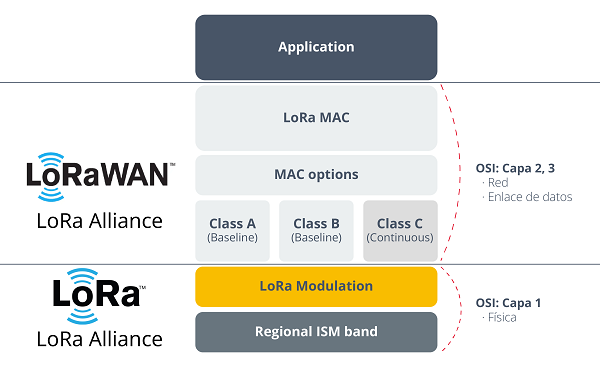
OSI model of layers on which LoRaWAN and LoRa are implemented. Source
Protocol architecture
LoRaWAN architecture is composed of a series of elements or nodes that form a star-shaped topology, in which they are connected to different gateways. These devices translate the received data and send it to the network server. In this type of network, the data transmitted by the elements is usually received by several gateways, so nodes are not associated with a particular gateway. In addition, if there is only one gateway in a network, it will also function as a network server.
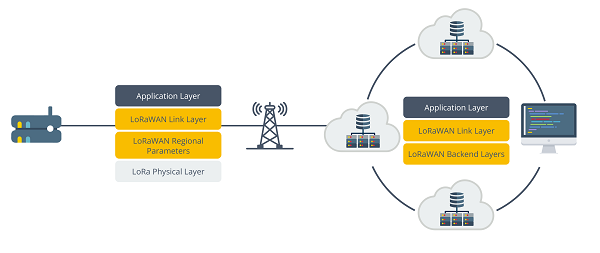
Architecture of a network implementing the LoRaWAN protocol. Source
The elements that make up the LoRaWAN architecture are the following:
- Node or end point: devices that send or receive information using the LoRaWAN network. These elements are usually sensors, actuators or trackers. These nodes communicate with the gateways using LoRa RF modulation to enable long-range communication.
- Gateway: these are devices that act as communication gateways between the end devices and the server, i.e. they receive the information transmitted by the nodes and forward it to the network servers. They are the most important elements of the network; without them communication would not be possible. Communication with the network server takes place via the SSL/TLS secure protocols.
- Network server: equipment in charge of processing and translating the information received from the nodes. In addition, they are responsible for the configuration of the network and the nodes that are connected to it. These servers can be local or hosted in the cloud.
- Application server: these are the servers responsible for processing the data transmitted over the network. They are independent of the LoRaWAN network, although they communicate with the network servers.
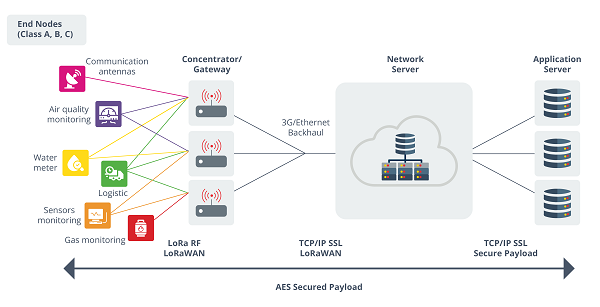
Elements of LoRaWAN Architecture. Source
End nodes in LoRaWAN networks can be classified into 3 classes, depending on the energy consumption or the way they handle communication:
- Class A: is the default class that all nodes must support to enable communication. This class of nodes always initiates communication asynchronously. It is characterised by sending listen-only windows (RX windows) after sending data, which allows communication to be bidirectional and enables devices to switch to sleep mode and therefore consume less power.
- Class B: devices of this class synchronise with the network by means of periodic beacons (these are packets generated by the gateway indicating the time when the transmission windows will be available). In addition, it allows nodes to create reception windows without prior transmission, which increases the device's ability to receive information at the cost of increased battery consumption.
Class C: In this class, nodes are in listen-only mode most of the time and only switch to transmit mode when necessary. As these devices are constantly listening on the network, they consume the most power, so it is recommended that they have a power supply connected.
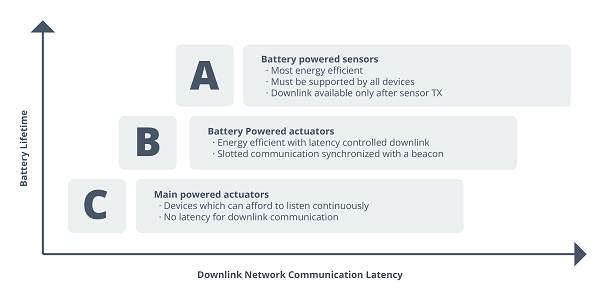
LoRaWAN Protocol End Node Classes. Source
LoRaWAN features
The LoRaWAN protocol is a protocol that has been designed to improve the IoT industry in many ways, as it has a number of features that minimise some of the problems that the industry was facing in this area. Among the advantages for the industry are the following:
- Open protocol: both the documentation and the protocol specification are publicly available. In addition, there is an association called the LoRa Alliance , which is made up of companies such as Microsoft, Amazon and Cisco, and which works to promote solutions and improvements related to this technology.
- Long-distance communication: this protocol allows long-range communication between devices, so that a single antenna can cover a large area of territory (between 10 and 20 kilometres, depending on the territory).
- Interoperability: LoRaWAN technology can be used in a wide variety of industries because the data being transmitted can be easily integrated into other control platforms.
- Low frequency transmission: by operating on low transmission frequencies, no licensing is required.
- Mobility and localisation services: even if the location of the nodes changes, the connection between the elements and the gateways is guaranteed.
- Low power consumption: devices using this technology have a low consumption of resources, so battery life is longer and they can operate uninterruptedly for long periods of time.
- Scalable technology: allows communication between a large number of devices through a single gateway, while maintaining quality of service.
- Low cost: LoRaWAN devices are relatively lower cost than other technologies, which is ideal for IoT deployments where a large number of devices are needed.
- Noise immunity: the combination of spread spectrum modulation and CSS techniques allows for robust communication.
- Communications security measures: this technology implements communications security and encryption mechanisms, such as AES-128 algorithms for encrypting data over the network. Security measures include:
- Mutual authentication through Over-the-Air activation and the use of an application key between the device and the network.
- Network traffic protected by two session keys.
- Application key and session keys stored on physically protected devices.
- Encryption of communications using AES-128 algorithms.
- Use of secure protocols such as HTTPS and VPN
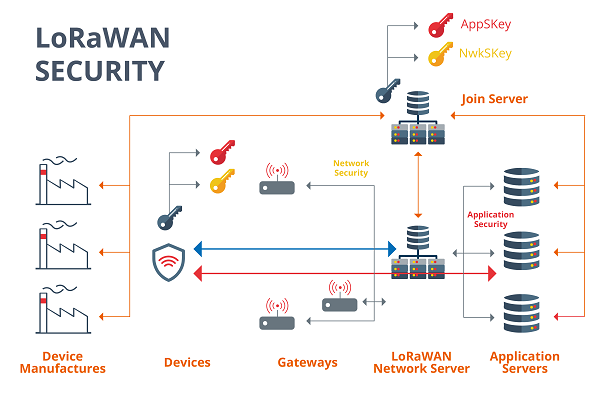
How secure communications work in LoRaWAN protocol. Source
IIoT Applications
LoRaWAN technology has characteristics that allow its implementation in different sectors within the IIoT field, such as energy, health, food or transport, among others. Some of its current applications in IIoT technology are:
- Asset tracking: Most industries need to know the status of their processes or machinery constantly and over long periods of time. Due to its low resource consumption, the use of this technology is quite useful for communication between different devices.
- Internet of Energy (IoE): this concept refers to smart electricity systems and the interconnectedness they offer. In this area, LoRaWAN technology provides long-distance communication, making it a good choice for connecting different devices in the IoE infrastructure.
- Environmental monitoring: communications between the devices of this protocol are robust and secure, allowing it to be deployed in areas where the information transmitted is critical. Examples of their use in this field are the detection of possible leaks in industrial machinery, the emission of gases harmful to health or the monitoring of air conditioning in the environment.
- Energy efficiency: LoRaWAN devices are also used in aspects related to the management and monitoring of energy, water or gas consumption data due to their low cost and low resource consumption.
- Food: this sector has many applications due to its long-distance communications, with which devices from several plots can be coordinated.
Conclusion
LoRaWANs have experienced a huge growth in IIoT over the last few years because of the features they offer to offset most of the problems that have arisen in the industry. Although not yet deployed in critical communications, its characteristics (including security, low power consumption and long range) make it a promising technology with a wide potential to overtake other established technologies such as TETRA, which is used in critical communications.









